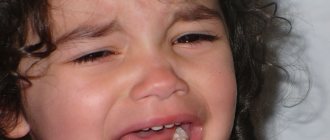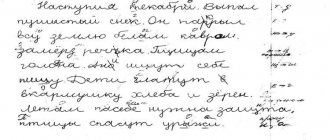Speech therapist
Bratanova
Olga Alexandrovna
Experience 29 years
Speech therapist
Make an appointment
Dyslexia is a disorder related to reading skills. Due to problems with certain mental functions that should be involved in the formation of such skills, a child may experience a variety of difficulties when working with text. Most often, it is difficult to recognize individual symbols and signs - as a result, the meaning of words, phrases or sentences is not captured or is distorted.
The problem appears from childhood and with proper correction can be leveled to a level that allows you to live comfortably and study effectively. But if you don’t pay attention to it at an early age, it remains in adulthood, causing a lot of inconvenience. At the same time, it is important to understand that dyslexia does not determine a child’s development in itself - he can effectively perceive information through other channels, for example, good listening comprehension.
Why dyslexia occurs - the causes of the disease
The main causes of dyslexia are neurobiological in nature. This is important to understand, because often, out of ignorance, parents and teachers attribute reading difficulties to the child’s “laziness” or “inattention,” only triggering the situation. But with such a deviation, certain areas of the brain are less active and also have a reduced density.
Additional causes of dyslexia (provoking factors) are:
- disorders that affect the balance between the two hemispheres of the brain;
- serious, severe infections affecting the brain – the most common example is meningitis;
- traumatic brain injuries;
- complications during childbirth and pregnancy: from infections to fetal asphyxia. During pregnancy, the mother’s bad habits also worsen the situation: smoking, drinking alcohol, and taking drugs.
Social factors also have a serious influence on this deviation. Moreover, they can be completely opposite in their orientation. Thus, symptoms of dyslexia can manifest themselves both from too much study load and from neglect - complete disregard for the child’s development. With isolation, lack of communication, and not a very good environment, the situation only gets worse.
However, let us remember that dyslexia is not necessarily a disease of children from disadvantaged families. Due to purely biological reasons, it can occur in children who live in excellent conditions and receive enough attention from adults.
Correction methods
In addition to the negative impact on a student’s academic performance, dyslexia negatively affects the development of his personality. Difficulties in mastering reading can provoke the emergence of such personality traits as self-doubt, shyness, anxiety, suspiciousness, isolation or aggression, irritability, negativism. Therefore, a special role belongs to the early detection and correction of this disorder.
If you consult a speech therapist when you notice the first signs of dyslexia, you can minimize its manifestations. The later the corrective work is carried out, the more time it will take to eliminate this violation.
To eliminate reading impairment, a unified system of correctional intervention is necessary, since very often dysgraphia, dyslexia, dysorthography do not exist in isolation, but most often accompany each other.
Main directions of correctional work:
- Development and improvement of phonemic perception (the ability to isolate given sounds, distinguish sounds that are similar in sound, for example: s-ts, ch-shch, r-l), not only in oral speech, but also in written speech. This work is carried out with the participation of a speech motor analyzer, therefore, simultaneously with the development of phonemic hearing, work is carried out on sound pronunciation;
- Work on sound pronunciation - eliminate deficiencies, practice articulation, form correct breathing, automate sounds in coherent statements, teach to distinguish sounds that are similar in sound;
- Development of sound analysis and synthesis skills. The main types of this work are: isolating sentences from the text, words from sentences, syllables and sounds from words, such analysis is accompanied by the compilation of various diagrams that simplify the understanding of the basic terms of the Russian language;
- In correctional work, great importance is attached to the development of mental processes: perception, attention, thinking, memory. For this purpose, various tasks and educational games are recommended. For example: “What has changed?”, “Find out by voice”, “Vegetable garden”, “Fill in the shapes with letters”, “Assemble the animal”, “Match by shape”, etc.
- Clarification of the meanings of words available to children and further enrichment of vocabulary by accumulating new words related to different parts of speech; familiarization with various methods of word formation and inflection. Development and further improvement of the grammatical design of speech based on mastering sentences of various syntactic structures: simple and complex.
- Improving coherent speech, working on the sentence as the main speech unit. We pay attention to punctuation marks, which activates the student to use correct intonation when reading. You can read the same sentence with different intonations. Read the text in different ways, for example: slowly - like a turtle, cowardly - like a bunny, melodiously - like a bird, loudly - like a bear and other types of work.
There are several methods for correcting dyslexia in schoolchildren. The most popular are the Ronald Davis method and the A.N. Korneva.
Ronald Davis method
Ronald D. Davis developed a method for eliminating dyslexia and opened the first clinic for reading problems.
The uniqueness of the method lies in the fact that it helps a dyslexic person learn to control manifestations of disorientation or lack of attention, teaches him to perceive the most difficult and complexly written symbols and words, and then translate them into images in his imagination, thereby filling in the gaps in perception.
The method is based on visual rather than verbal thinking. It contains three main stages:
- Learning to “control” the alphabet and linguistic signs, for example: by fashioning them from plasticine. When a child makes letters on his own, he touches them and imagines their image, which improves his handwriting.
- Learning to “control” abstract words, which a dyslexic has no image of.
- Formation of the skill of consistency and understanding in the reading process.
The Davis method not only teaches writing, it develops self-organization skills: it develops a sense of time, order and duration, and teaches concentration.
Methodology A.N. Korneva
It is called “Correction of persistent inability to master reading and writing” and is used to correct dyslexia in primary schoolchildren.
The technique is aimed at early detection of insufficient development of processes necessary for mastering the school curriculum and speech development of children. But these tests are often used by teachers when organizing work with dyslexics.
Types of dyslexia
Before describing the specific symptoms of the disease, let's talk about the types of dyslexia. At the moment there are six of them.
- Phonemic (acoustic). According to the classification, dyslexia is the most common problem that often occurs in primary school students. With this problem, children rearrange syllables and distort the structure of the word - for example, instead of “cat” they read “current”.
- Ungrammatical. It assumes errors in composing constructions, for example, a person may incorrectly use endings, cases, tenses (“white table”, “I be hungry”).
- Semantic. He understands every word that a person reads, but separately from the entire text. But he cannot assemble words into sentences or into other, even more complex structures - therefore it is impossible to grasp the meaning of what was read. For this reason, dyslexia in adults and children does not allow them to obtain enough information from books.
- Mnestic. This is a problem at the level of individual letters and sounds, which do not allow one to assimilate or understand the entire word.
- Optical. Here deviations occur at the visual level. For example, a dyslexic person sees a word backwards (mirrored) or cannot keep his eyes on the line he is reading - his eyes constantly slide across the page, not allowing him to adhere to the desired reading sequence.
- Tactile. Specific dyslexia occurs in people who are blind and use Braille to read. With this deviation, letters identified by touch are either perceived incorrectly (they are confused with similar ones) or “slip away” - a person cannot stay on the desired line.
With these types of dyslexia, the symptoms of the disease will be extremely varied and ambiguous.
Classification
The child may not be able to distinguish between individual symbols and letters, and then doctors talk about a literal disorder, and if the child generally has difficulty perceiving words and sentences, the verbal form of the disease is diagnosed.
In accordance with the impaired mechanisms of speech perception in children, the following types of dyslexia are distinguished:
- phonemic, developing due to a violation of the ability to recognize, analyze and differentiate individual sounds, letters and syllables;
- semantic, due to a weak vocabulary, the inability to combine individual syllables into whole words;
- agrammatic, when the child does not understand the structure of the language, by what rules phrases and sentences are built;
- mnestic, in which children have difficulty relating sounds to letters and suffer from speech memory disorders;
- optical, associated with insufficient or abnormal formation of visual-spatial perception.
Tactile dyslexia is also distinguished separately: this form of disorder is typical for visually impaired children, when they have difficulty recognizing symbols through tactile sensations.
Symptoms by age
To detect dyslexia, it is necessary to know the full range of signs characteristic of this disease. And there are difficulties here, because there are a lot of manifestations - moreover, many of them differ in age. Let's start with general points, and then we'll talk about what to pay attention to at different ages of the child.
Common symptoms of dyslexia:
- problems with concentration, attention and memory;
- difficulties with orientation in space - for example, when a child confuses right and left, top and bottom;
- difficulties with simple and more complex tasks: from fulfilling a basic request to learning the alphabet and multiplication tables;
- changes in the sequence of letters, syllables, numbers when writing and reading information;
- inability to work well with pens, pencils, etc. If a child needs to write something, he clumsily uses the writing instrument;
- reluctance to read aloud, write, etc. Actions that are very difficult or in which many errors are later discovered cause psychological discomfort in children.
Even some of these signs are a reason to go to the doctor and start dealing with the situation. At the same time, it is very important for parents not to scold the child, not to put pressure on him, forcing him to do something that he cannot do. A softer and more balanced approach is needed here.
They take into account not only the forms of dyslexia, but also how the problem shows itself over time, at different times.
In preschool age, the disease manifests itself as problems in speech, difficulties in learning, and pronunciation of different words. The child is often confused and does not remember even a short set of phrases. It is difficult for him to master basic reading and writing skills, he confuses words and letters. All this can easily affect the quality of communication with classmates and peers - it becomes worse.
At primary school age, problems manifest themselves not only at the level of words and syllables. It is already difficult for a child to remember facts; he gets confused in arithmetic signs. The condition is reflected in the development of new information. Problems of a different nature also continue: behavior becomes awkward, impulsive, and coordination of movements is impaired.
At middle school age, a diagnosis of dyslexia shows poor reading quality and poor memory. The child also reads and pronounces words poorly. Difficulties cause rebellion, so the student refuses to read and write, he has difficulties with gestures and facial expressions, and problems in communicating with peers intensify.
At high school age, problems remain with writing, reading, memorizing, and reproducing information. A slow speed of work develops, which makes the teenager seem “lazy.” Moreover, the problem extends further - often dyslexics have difficulty adapting to any changes in life.
Symptoms of dyslexia in adults include problems with writing and reading, with added absent-mindedness and inattention. An adult with such an illness often does not know how to plan his time - the quality of life decreases.
Are you experiencing symptoms of dyslexia?
Only a doctor can accurately diagnose the disease. Don't delay your consultation - call
General information
Most often, dyslexia is diagnosed in younger schoolchildren during preparation for education or in the first grade.
Teachers and parents notice that while reading, the child does not reproduce certain sounds, swallows them, or pronounces them incorrectly. There may also be a problem with recognizing punctuation marks, which is why the child places intonations incorrectly when reading, confusing where the beginning and end of the sentence are. In most cases, signs of dyslexia in primary schoolchildren and adolescents are combined with symptoms of dysgraphia, another disorder of higher mental activity associated with writing impairments.
Treatment and correction of dyslexia in Moscow
Speech pathologists and psychoneurologists can make a diagnosis of dyslexia. A speech therapist, whom parents often turn to if they notice problems with speech or reading in a child, can also refer you for additional examination.
Experts say that no two dyslexics are alike, so treatment for dyslexia is individualized. Often difficulties remain with a person for the rest of his life - and then it is important to understand how to improve its quality, how to help a child cope with the main tasks of life. In other situations, a fairly high-quality correction is possible. For these purposes, a special speech therapy program is selected. It is based on the type of dyslexia, the person’s age, as well as his personal characteristics.
Drug treatment for dyslexia remains questionable at this time.
Diagnostics
A child who has signs of a reading disorder must undergo a full speech therapy examination, which consists of a sequential assessment of speech, writing skills, reading and the quality of non-speech processes (attention, ability to focus on text, memorization, etc.).
The specialist also checks the state of articulation, clarity of diction, and characterizes speech and manual motor skills. In general, diagnostic measures can be divided into three areas:
- assessment of oral speech, which includes studying the characteristics of the child’s sound pronunciation, the volume of his vocabulary, the level of phonetic-phonemic development, and the ability to work correctly with the structure of the language;
- assessment of writing skills, which involves performing various tasks such as rewriting texts, writing by ear, and independently writing words and sentences;
- neuropsychological assessment, including analysis of the child’s optical-spatial orientations, the degree of formation of visual recognition and memorization of printed objects.
Additionally, the speech therapist can refer the child for a neurological and ophthalmological examination. An important stage in diagnosing dyslexia is also the study of the child’s lifestyle, the characteristics of his environment, and the psychological situation in the family.
Common questions and answers
Is it possible to cure dyslexia completely?
It all depends on the specific situation. Sometimes it is possible to correct the problem to such an extent that it does not affect future life. But it is important to start work on time.
Who treats dyslexia?
We have already partially answered this question about dyslexia, what it is and how to treat it. After making a diagnosis and excluding other pathologies, the main treatment is carried out by a speech therapist according to a special program.
Is dyslexia always an intellectual problem?
In no case. With the right approach, a child with dyslexia can not only get a good profession, but also become very successful in it. Suffice it to say that such famous people as Steve Jobs, John Lennon or billionaire Richard Branson were dyslexic.
Dyslexia is by no means a death sentence, but a problem that requires careful attention from adults. If they put in the effort and time, the child will have a chance at a good education and a great future.
Other methods for assessing the risk of developing dyslexia in preschoolers
Consider a battery of risk tests implemented in other language settings as predictors of dyslexia. Partially, these tests can be used starting from 5 years of age, which distinguishes them favorably from the domestic methodology discussed above.
Rapid Serial Naming Test
The test was developed by an international group of experts and tested for different age groups. Beforehand, a training task is performed, during which the researcher must make sure that the child knows the necessary names. The normal execution time for each task is 1 minute.
Serial image naming
The child is offered stimulus material with a set of repeating pictures (36 images). The task consists of quickly naming the depicted objects out loud. Errors made and execution speed are taken into account.
Serial color naming
The child is offered stimulus material with a set of repeating colors, which he must name as quickly as possible.
Serial letter naming
The child is offered stimulus material with a set of repeated letters, which he must name as quickly as possible.






